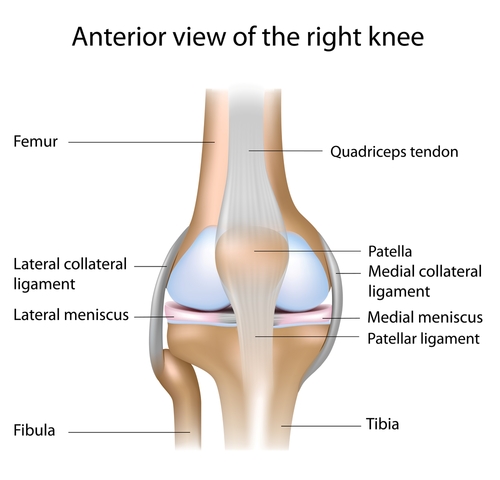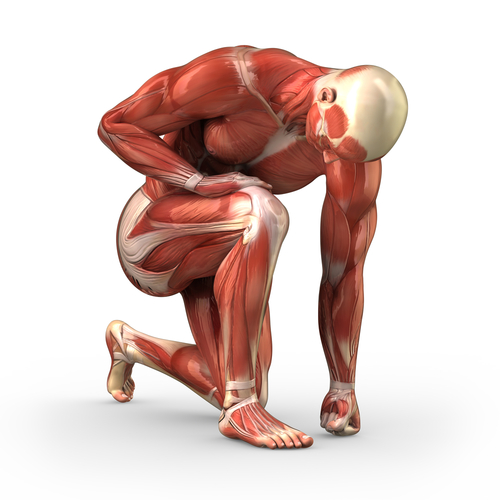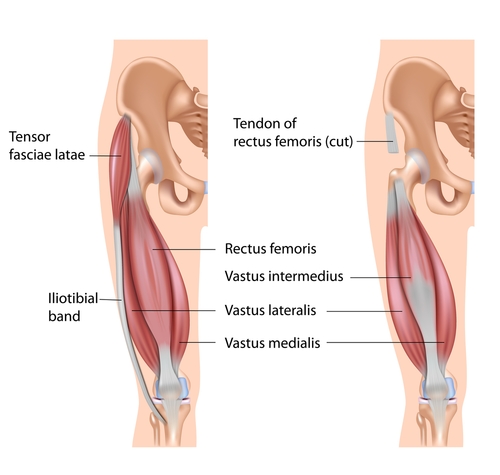The knee is the largest joint in the body and acts as the link between the upper and lower leg enabling you to transfer power from the big powerful muscles in the hips and butt, down though your foot to Terra Firma. This translates into the force vector that propels us up and down mountains in our pursuit of game.
Knee injuries result in over 10 million doctors’ visits every year in North America, making it one of the most injury prone joints in the human body. These injuries can be put into two general categories, traumatic and overuse injuries. Both can be debilitating and remove us from the hunt or worse, leave us stranded deep in the mountains. There are many things we can do to reduce the risk of either type of injury during our hunting adventures. It helps to approach it with a “prehab” state of mind as this allows us to make it through the hunting season injury free and will increase the number of years we can pursue game, even in the most formidable environments.
To gain a better understanding of these injuries it helps to have a general knowledge of knee anatomy. The joint itself is made up of four bones, four ligaments, cartilage, a couple of menisci (plural of meniscus), a joint capsule, and is crossed by numerous muscle groups. It is also surrounded by a number of bursae, which help reduce friction and allows for free movement.
The femur (thigh bone), the tibia (large lower leg bone), the fibula (small lower leg bone) and the patella (knee cap) are the bony components. The bones are held together by four ligaments, which connect bone to bone. They are the medial collateral ligament (MCL), lateral collateral ligament (LCL), posterior cruciate ligament (PCL), and anterior cruciate ligament (ACL). There is also a joint capsule, which is a bundle of connective tissue encasing the joint. There are also two forms of cartilage inside the knee: the smooth ends of the bone that glide on each other and the meniscus, a softer form of cartilage that works like a shock absorber.
As far as muscles are concerned, you’ve got the hamstrings (back of the thigh), the quadriceps (front of the leg), gastrocs (calf muscles), and a number of other muscles that perform a combination of leg motions such as in and out (abduction/adduction respectively). Many people believe that these large muscle groups are responsible for the stability of the knee joint, but 90% of the stability actually comes from the passive supporting structures (ligaments), which is why a torn ligament in the knee can lead to knee instability.

Prevention of these traumatic injuries starts many months before hunting season and should involve a regimented strength and conditioning program involving full body movements in both stable and unstable footing environments. Stretching, self-mobilization (i.e. using tools like a foam roller) and range-of-motion exercises are also important to allow our muscles and tissues to work properly through a full functional range of movements of positions. Limitations in range-of-motion represent require other areas to move and/or work more which in turn leads to additional load and fatigue. The mountain athlete should always maintain a high level of cardiovascular fitness to allow them to move through difficult terrain without developing excessive fatigue, as this will further increase the risk of injury.
Your strength and conditioning routine should involve compound movements that simulate mountain hunting motions to help develop core, hip, and leg strength. Exercises like the dead lift, farmer drag and/or carry, Turkish Get Up (TGU), kettle bell swings, step ups, Bulgarian lunges and squats can all be great ways to develop your core and lower limb power for easier travel in the mountains.
Challenging your balance with simple exercises like step lunges onto a Bosu ball or soft piece of foam will help improve your proprioception and develop better kinesthetic awareness but it should be noted that nothing compares to training outside and using natural features like logs, rocks, and other uneven surfaces to perform these exercises. Proprioception and kinesthetic awareness training teaches our bodies how to react quickly to any footing that may be encountered during hunts, for example when the ground is blanketed in light snow. Although it makes tracking amazing, branches, logs, rocks and holes can be hidden and result in serious injuries if our bodies are not adequately prepared.
 The majority of injuries I see in the general population, weekend warriors and avid outdoors people are overuse injuries. Overuse is a bit of a misnomer. These injuries are typically the result of biomechanical faults, strength imbalances or tissue tensile imbalances, and are not truly “overuse” in nature. They are the result of off-angled forces that stress tissues in ways they weren’t designed to handle, causing a breakdown or micro trauma in the affected tissues.
The majority of injuries I see in the general population, weekend warriors and avid outdoors people are overuse injuries. Overuse is a bit of a misnomer. These injuries are typically the result of biomechanical faults, strength imbalances or tissue tensile imbalances, and are not truly “overuse” in nature. They are the result of off-angled forces that stress tissues in ways they weren’t designed to handle, causing a breakdown or micro trauma in the affected tissues.
I often refer to the knee as “the canary in the coal mine” for lower limb problems (hips to feet) because the knee is seldom the root issue itself but is often the first area to present with symptoms or signs of a problem. This is because when compared to the hip or the ankle, the knee is primarily a hinge joint and has a relatively low range of motion outside its pure hinge functionality. The ankle and hip however are both triplanar joints (move in all 3 dimensions) which results in more movement in multiple ranges of motion, giving them more wiggle room to adapt to biomechanical faults and the uneven surfaces we encounter in the field. As mentioned, these biomechanical faults are typically driven by inadequate strength, muscle imbalances, fascial (connective tissue) tightness, poor proprioception and kinesthetic awareness, previous injuries or poor neurological innervation.
The two most common “overuse” problems that I see at the knee are patella femoral pain syndrome (PFPS) and IT band syndrome. These problems can have many different causes that typically originate at the hip, lumbar spine or lower leg. Patella femoral pain, for example, can be caused by inadequate VMO (vastus medialis oblique) strength, an over-tight quadriceps muscle, an increase in repetitive jumping, an increase in running/hiking mileage, over-pronation of the foot, a growth spurt in youth, and poor recruitment (the ability to “activate” a muscle neurologically) of the gluteus medius/maximus muscles to name just a few of the causes.
The structures and areas I find the most commonly associated with these problems are tightness of lateral leg muscles and connective tissues typically due to overactive hip/leg stabilization, and the rectus femoris muscle itself. The outside of the leg is comprised of the lateral fascial, the TFL muscle, the lateral quadriceps and borders the biceps femoris on the back side of the leg. This area can not only cause lateral knee and leg pain and IT band syndrome, but can contribute to patella femoral pain syndrome as well. The other area to focus on is the quadriceps muscle. The quadriceps muscle, specifically the rectus femoris, will increase the tension through the patella tendon and increase the compression of the patella on the femoral condyles during flexion and extension.

To self-treat these areas you can either use a Trigger Point Roller or other foam roller, or The Stick, to “roll out” the tissues and muscles. Focused stretches completed after performing some form of self-treatment will help further alleviate potential problems. The final piece of the puzzle, especially important for side hilling, is strengthening the core and gluteus medius. Our bodies are adept at recruiting other muscles for a given job if we have inadequate strength in the muscle or muscles that are supposed to be doing the bulk of the work. It’s simple physics, if a given muscle or muscle group is compromised in some way other muscles have to pick up the slack. This is workable for a period of time but will only lead to additional fatigue and reduced performance. This happens a lot with the gluteus medius muscle, TFL and IT band syndrome.
Two easy exercises to target the core and help develop the gluteus medius are:
- Bridging with a resistance band (video here). Use a resistance band around the knees to bridge up to a neutral spine position, while maintaining gluteus activation to keep the knees apart. (See picture below). Try and work toward 4-5 sets with 60-90 second holds and enough resistance that the muscle fatigues.
- The good old fashion side plank. The key to the side plank is to make sure that you are not rolling forward to bias the use of the TFL muscle which will only contribute to the problem (see picture below). Work on increasing the duration that you can hold it and aim for 4-5 sets of 60-90 seconds at a time.
There are a variety of other interesting and complex exercises that can be used to target these specific muscles, but it is best to get guidance from a trained professional to make sure you’re actually targeting the right muscles and that you’re undertaking a program that is demanding enough to create the results you want.
The areas that typically require rolling, or use of The Stick, are the lateral leg and the quadriceps muscle. This can easily be accomplished by using a foam roller and working through the tissue tightness or using The Stick to melt away the tight areas. I typically tell people to roll or self-release areas until the tissue has a more relaxed feeling and they no longer have any really focal areas of discomfort when moving the roller across the skin (see video or picture below)
Ultimately, as we venture deeper into the wilderness in pursuit of game our fitness becomes one of the most important variables we can control. But fitness isn’t just about working hard at the gym or on our training hikes. Being truly fit also means taking a proactive approach to the most important “equipment” we own, our own bodies! If you want to hunt hard for years to come and ensure you can handle everything the mountains throw at you, a little “bombproofing” in the off-season goes a long way to helping you handle the demands of a serious mountain hunt.


